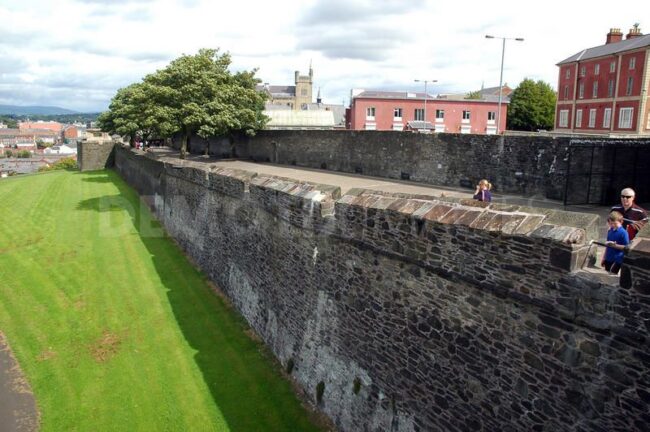
Major dig to get underway soon at Derry’s Walls
The excavation, the first in over a decade, will take place in the area beneath the City Walls above Fahan Street and is being undertaken by Queen’s University’s Centre For Community Archaeology and a host of partners, including The Friends of the Derry Walls.
Geologist with Queen’s University Commmunity Archaeology Programme Alastair Ruffell was in Derry recently to conduct a Ground Penetrating Radar scan on the grassy bank where houses once stood at Nailors Row, beside the historic Walls.
Mr Ruffell was joined by representatives from The Friends of the Derry Walls and explained that they were looking to find a ditch in the area.
He added that these results will give the team a better idea of where to excavate when they come in September to do the major dig.
Ruairí Ó Baoill from Centre for Community Archaeology will be the site director for the excavation – which is being funded by The National Lottery Heritage Fund.
It is hoped that the community excavation will take place over two weeks from September 4 to 18, subject to the approval of the Historic Environment Division at the Department for Communities.
The plan is that archaeologists will host morning excavation sessions for local school children, while afternoons will be reserved for adult volunteers.
It is hoped that the proposed excavation at Nailor’s Row will allow the archaeologists to:
investigate anomalies, possibly ditches, recorded in two geophysical surveys, carried out in 2017 and 2024,
investigate any archaeological deposits and features away from the 17th century town wall
and thirdly to possibly uncover material and features relating to the Derry people who lived on Nailor’s Row in the 19th and 20th centuries.
In a statement The Friends of the Derry Walls confirmed that local people can now register to take part.
“It’s 11 years since the last big dig in Derry, and we have another one coming to the city in September, and even better, you can be a part of it.
“Members of the public, schools, community groups and really anyone interested in helping for a few hours and getting their hands dirty, can register to take part in the Derry Town Ditch Dig scheduled for this September.”
Derry city is one of the oldest continually inhabited settlements in Ireland and the only city with its ancient walls still intact.
The Walls were built between 1613 and 1618 during the Plantation of Ulster and the city within them was built to a pioneering grid pattern on what had already been for centuries a thriving settlement and port with an ancient cathedral near the modern day Long Tower dating back to the 1200s.
Derry traces its origins back further to St Columba in the 6th Century AD but previous archaeological work has found evidence of settlements in the region dating back 6,000 years to the neolithic period in the Thornhill/ Culmore area of the city.
The last major dig in the city was back during the City of Culture year in 2013 when ancient skeletons were uncovered beneath the Bishop Street car park area on the other side of the Walls from where the forthcoming dig is to take place.
Other sites of interest previously explored and examined include Elagh Castle, the ruins of which can still be seen close to the border on the Derry side at Bridgend, Boom Hall, Prehen and at the ruins of St Brecan’s Church in St Columb’s Park.
For updates check out The Friends of the Derry Walls Facebook page and you can register your interest to take part in the dig at: https://forms.office.com/e/y3HWrzhecP
Tags:




